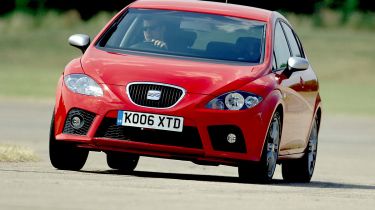SEAT Leon 2.0T FSI FR
SEAT's Leon FR is a performance bargain: cheap to buy and run, fast and well built
When it comes to giving the FR a racy appearance, SEAT’s designers have a big advantage. Due to the standard Leon’s long and low, coupé-like shape, even the base model looks sporty.
There’s plenty of pleasing detailing, with the teardrop headlights, stylish tail clusters plus hidden rear door handles, and the FR complements these with unique bumpers and subtle badges. The Leon is undoubtedly an attractive machine and, having been designed uniquely as a five-door, its rear doors are integrated very well indeed.
The low roof does mean access to the back seats is tighter than in the Focus, but once inside, space is virtually the same. However, the boot isn’t great; a high lip hampers the 341-litre bay.
All the buttons on the simple dashboard are located close to hand and the cabin is very driver focused. There’s an excellent range of seat and wheel adjustment, while the FR’s sports chairs are comfortable and supportive. The only problem is the blind spots caused by the A-pillars. The robust build quality is impressive, although some of the plastics are rather brittle and the dark cabin feels a little claustrophobic.
However, driver enjoyment is key here, and the Leon scores well thanks to the chunky steering wheel and spot-on seating position. Once on the move, the firm suspension makes it clear this is a tighter offering than more basic variants. Body control impresses and, crucially, the wheel responds well to inputs, while front-end grip is strong.
Used - available now

2024 Vauxhall
Mokka
9,304 milesManualPetrol1.2L
Cash £16,887
2021 Ford
Focus
33,733 milesManualPetrol1.0L
Cash £12,500
2022 Volkswagen
ID.3
26,587 milesAutomaticElectric
Cash £14,900
2024 Volkswagen
Golf GTD
29,886 milesAutomaticDiesel2.0L
Cash £23,200The FR doesn’t have the same delicacy to its steering as the ST, though, and its chassis is never as communicative or adjustable. Unlike in the Ford, small throttle adjustments or steering corrections are not followed by an instant reaction. But the Leon is a stable, balanced and reassuring hatch – although it’s not a smooth-riding one.
This is where the FR really falls down. We can make allowances for sporting cars, but the SEAT doesn’t have the ST’s compliancy, is hard on country roads and can get crashy in town – so comfort isn’t a strong point. The brakes are firm underfoot, and the Leon stopped from 60mph in 36.6 metres – just over a metre longer than the Focus. Acceleration was less competitive, too. While peak power is delivered nearly 1,000rpm further down the rev range, the FR’s smaller engine offers 25bhp less, and also trails by 40Nm in the torque stakes.
Given that the Ford has a five-cylinder engine, we’re surprised the SEAT is only 19kg lighter. This, combined with the power deficit, means the car was 0.8 seconds behind in the 0-60mph sprint, while at the test track the gap grows to 3.4 seconds by 100mph. Still, in real-world terms the FR copes well, and is less than a second slower than the ST in each of the in-gear increments.
The engine is punchy and flexible, but lacks the five-cylinder Ford’s warble and, strangely, doesn’t have the same raspy exhaust note as the Golf GTI. However, with stability control, six airbags and a CD player all standard, the £16,995 price means the Leon offers excellent performance per pound.
Details
Price: £16,995
Model tested: SEAT Leon 2.0T FSI FR
Chart position: 2
WHY: It’s a tradition that SEAT offers its FR models in petrol and diesel guises. The 168bhp Leon 2.0 TDI costs £17,495, but we test the £16,995 197bhp 2.0 turbo FSI. The use of the VW Golf GTI’s engine and some of its underpinnings bodes well.
Residuals
Our experts predict that the Leon FR will retain 48.7 per cent of its value over three years. That’s just over three per cent more than the Focus, and the SEAT is set to be worth £8,277 at the end of that period.
Servicing
Three checks on these two cars cost roughly the same amount. But the Leon needs to visit the garage every 10,000 miles to the Ford’s 12,500 miles, while SEAT has a smaller dealer network, too.
Tax
Not only does it cost less to insure, but the FR is also cleaner. It’s six tax brackets below the ST; add the cheaper list price, and the SEAT is a far more tempting fleet buy. Higher-band owners save £675 annually.
Insurance
Cover is always a consideration with performance cars, and the FR has a big advantage here, as it sits in group 14 – three below the ST. So the Spanish machine is £227 a year cheaper to insure: a big saving.






